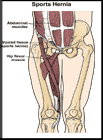
Sports Hernia
What is a sports hernia?
A sports hernia, also known as athletic pubalgia, is a tear in the muscles of the lower abdomen. It causes pain in the lower abdomen or groin.
Men get athletic pubalgia more commonly than women.
How does it occur?
The pain from a sports hernia usually begins slowly. There are different theories about how this hernia occurs. One possibility is that tight or strong hip flexor muscles tilt the pelvis forward and stretch the lower abdominal wall muscles, eventually leading to small tears in the muscles and tissues.
Activities that require a lot of bending over and leaning forward can lead to this problem. Athletes who play soccer, ice hockey, rugby, field hockey, tennis, or run track are most likely to get a sports hernia.
What are the symptoms?
Symptoms include:
- lower abdominal pain
- groin pain
- pain just on one side
- pain that is usually worse with sudden movements such as sprinting, kicking, side-stepping, sneezing, or coughing.
How is it diagnosed?
Your health care provider will take your history and do a physical exam. You will have tenderness in the lower abdomen and at the top of the groin. There are no tests that help diagnose this condition. Some tests might be done to rule out other conditions that cause groin pain.
How is it treated?
The initial treatment for a sports hernia is rest. Healing will take longer if you continue to participate in activities that cause you pain. It may take a few weeks to a few months for symptoms to go away. Anti-inflammatory medications (such as ibuprofen) and using an ice pack on the area for 20 to 30 minutes 3 to 4 times a day will decrease the discomfort Your health care provider may recommend physical therapy.
If rest and physical therapy do not relieve symptoms, surgery can be done. During surgery, the lower abdominal muscles and connective tissue are released and reattached and some hip muscles are loosened.
People who have had sports hernias sometimes continue to have ongoing lower abdominal muscle pain and groin pain.
When can I return to my sport or activity?
The goal of rehabilitation is to return you to your sport or activity as soon as is safely possible. If you return too soon you may worsen your injury, which could lead to permanent damage. Everyone recovers from injury at a different rate. Return to your activity will be determined by how soon your abdominal muscles recover, not by how many days or weeks it has been since your injury occurred. In general, the longer you have symptoms before you start treatment, the longer it will take to get better.
You may return to your activity when you can bend at the waist to touch your toes and straighten back up without pain. You should be able to do a sit-up or abdominal crunch without pain.

